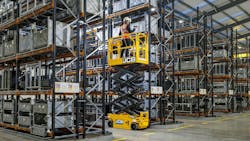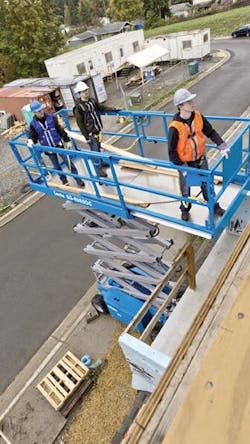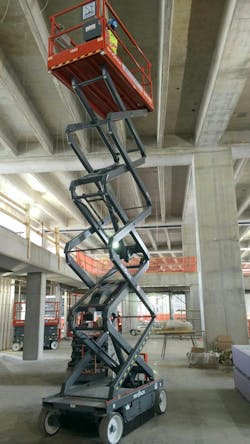How to Choose an Electric Scissor Lift
Scissor lifts have carved their vertical niche in both indoor and outdoor work, and manufacturers have expanded the number of electric models available based on demand from both rental houses and contractors.
Some scissor OEMS offer more than a dozen models of battery-electric powered units.
Working heights for scissor lifts range from 19 to 50 feet, and load capacities can go up to 2,700 pounds, depending on the height desired. Many models are drivable at full height, eliminating the need for the operator to lower the platform in order to move.
Read more: The Latest Electric Scissor Lifts
"When choosing a lift for your project, consider the heights you need to reach, the weight you need to carry, and the terrain you want your lift to be able to handle," said Dozr CEO Kevin Forestell. "Whether you want to reach 70-plus feet outdoors or just 19 feet indoors, you can be sure to find a scissor lift that can help you work more safely and effectively.
"And before you choose your model, make sure you take a more detailed look at the specifications to ensure it suits your needs," Forestell said.
Genie, Skyjack, and JLG lead the way in terms of numbers of electric scissor models available.
Genie scissor lifts
Managers concerned about cold temperatures should know that E-Drive Lithium-Ion scissor lifts are engineered to perform in temperatures ranging between 120 F to -20 F.
“When in use, electric machines with a standard FLA battery usually generate enough heat in the battery to continue working. However, most people aren’t continuously lifting or driving; they’re stopped and doing work, allowing the FLA batteries to cool," Dube said.
"As the FLA battery gets colder, it delivers less energy, which means the operator needs to take a break and move the lift into a warmer environment,” Dube said. “Genie Lithium-Ion batteries have built-in heaters that maintain the proper temperature, even when the scissor lift is stationary. This allows the operator to work continuously, without taking a break to warm up the battery—a real productivity benefit in a cold environment.”
As far as charging, the Lithium-Ion scissor lifts can be recharged in four hours, which Genie said is 33% faster than a standard FLA battery. Also, partial charges won’t damage the Lithium-Ion battery. This allows operators to charge a lift during breaks or over lunch in the event the machine didn’t get charged the night before, or if it is being used for a second shift.
MEC NetZero scissors
Ten MEC NetZero models are available, ranging from 10- to 45-foot platform heights.
With working heights from 16 feet to 51 feet and indoor/outdoor capabilities in certain models, the line includes the Nano10-XD, 1330AE, Micro13AE-XD, MMAE16, Micro19AE, Micro19AE-XD, and Micro26AE.
"All NetZero all-electric models are also designed to optimize the battery’s duty cycles and maximize energy efficiency during operation, which reduces operating costs and saves money," said Gary Crook, VP of engineering at MEC.
NetZero lifts are powered entirely by AGM or a Lithium-Ion batteries. All are designed with all-electric actuators that replaces a traditional hydraulic system. This design is meant to remove the risk of hydraulic fluid leaks, which can create conditions that pose hazards to workers and potentially damage finished flooring.
Additional benefits of the engine-free NetZero range design are zero emissions and zero noise. Noise-free equipment is especially important when working in sound-sensitive environments, such as residential neighborhoods, and indoor facilities, such as shopping centers and grocery stores. No operating noise translates into improved working conditions for operators and bystanders and less disruption for surrounding areas.
How to maintain electric scissor lifts
Although electric lifts may not have some of the same requirements as those units with internal combustion engines, there are still important items to check and service.
"Keep in mind that there are several types of scissor lifts with different maintenance requirements," Nunez says. "The main types of scissor lifts include: Battery-powered scissor lifts that feature either hydraulic or electric drive and rough-terrain machines which feature batteries with electric drive, diesel- or dual-fuel engines with hydrostatic drive systems."
Read also: What to Know About EV Maintenance
Nunez says that because each model has different components and features, service technicians must refer to the original operator’s manual and service and maintenance manual for guidance on proper inspection and maintenance.
A function check must also be completed before each use in an area free of overhead and ground-level obstructions. Accessories and attachments should also be inspected.
"Batteries are among the most frequent and highest cost drivers for scissor lift owners," Nunez said. "A poorly maintained battery may need to be replaced within one year, whereas a well-maintained battery can last as long as three years."
Remote diagnostics on scissor lifts
JLG offers a battery-monitoring system that remotely analyzes charge and usage, and provides diagnostic information. The system logs charge history and details on the machine controller, and a hardware module provides wireless connectivity and interaction. When used together, system components offer real-time information, including accurate state-of-charge, battery depletion tracking, fluid level monitoring, and charging history.
"On all-electric scissor lifts, the host of electric components can easily report their health status without requiring a technician to check/adjust valves, pressures, and other items seen on traditional scissor lifts," Nunez say.
The JLG Davinci AE1932 has self-diagnostics that allow operators to test all systems on their mobile device, eliminating the more traditional hand-held analyzer.
It operates on a single Lithium-Ion battery that can last more than 120 months, so owners may never have to replace a battery during the machine’s lifespan," Nunez said. "Opportunity charging and energy recovery while the platform is being lowered contribute to a 70% decrease in power consumption allowing for the use of one single lithium-ion battery that charges from discharged to fully charged in 3.5 hours.








